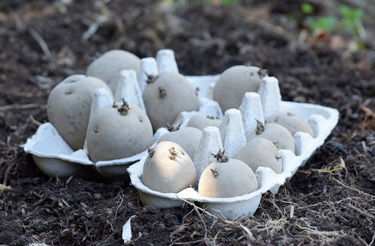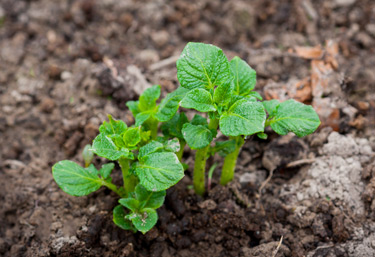Grow potatoes - an early crop
A sunny patch of soil, a tub, a bucket or a sack is all you need to grow a satisfying crop of potatoes to harvest in time for Christmas. Planted in mid-winter, they may be ready to eat as early as October or November.
Start with quality
Early potatoes start arriving in garden centres in June or July. The tubers (‘seed potatoes’) sold in garden centres are certified seed for guaranteed success. Those saved from the previous year, or bought at the supermarket might grow but the yields are likely to disappoint. This is because potatoes are susceptible to diseases. When starting out as a potato grower it’s fun to try a few different varieties as they vary greatly in texture and flavour. Consider swapping and sharing with friends if you only have space to plant a few. A good sized seed potato is about the size of an egg. Larger ones can be cut in half but this can make them susceptible to fungus diseases.
Sprout for success
With winter planting, pre-sprouting seed potatoes makes for rapid growth after planting. Lay the tubers in trays and place them in a light airy place, not a dark cupboard. Without light the sprouts grow long and weak which break off too easily at planting time. Once the shoots reach 40-100mm long, its time to plant. This takes two to eight weeks, depending on temperature.
Prepare the patch
For best results, potatoes need full sun and well-drained fertile soil. The very best yields come from loose but moisture retentive soil. Heavier soils can be improved by adding compost or gypsum. Gypsum helps loosen clay and compaction without upsetting the soil pH. Potatoes prefer a lower pH than most vegetables. If growing potatoes in sacks or containers, use a good quality container mix and make sure the container is adequately drained.
There are various ways to provide the nutrition potato plants thrive on. A general fertiliser or potato food can be mixed into the soil before planting. Well-rotted animal manures also provide effective nutrition but are best placed below the level of the tubers where the roots will reach them, taking care not to have tubers in direct contact with concentrated fertiliser.
Trenching
Potatoes need not be planted in rows. They grow just as well in rounded mounds. But the traditional trench makes for easy management. In trenches 20cm deep, space tubers about 30cm apart with their sprouts pointing upwards. Then partly fill the trench, covering the tubers with just 5-10cm of soil. A long handled hoe is the easy way to keep the rows free of weeds as you mound the soil around the plants as they grow. Keep the top half of foliage uncovered. The new potatoes form between the seed potato and the soil surface, while the leaves manufacture energy for their growth. Near harvest time keep the soil mounded to prevent tubers being exposed to the sun.
Wise watering
Keep the soil moist as the potatoes grow, most importantly at flowering time when the baby potatoes are forming. Water early in the day so that the leaves have time to dry before nighttime.
Digging the treasure
Early potatoes can be harvested all at once but you don’t have to wait that long. As soon as the first tubers are big enough, even if the flowers are still open, you can gently loosen the soil, reach under the plant, and take the largest tubers, leaving the tiniest ones to keep growing.
Managing pests and diseases
One of the advantages of growing potatoes during cooler weather is that pests and diseases are less of a problem. Crop rotation is the most important way to avoid disease problems like blight. Ideally potatoes should not be grown in the same soil more than once in three years. Regular spraying with copper (once a fortnight) is an effective way to prevent disease problems.
The Tomato and Potato Psyllid (TPP) gets active when the weather warms up in late spring, but covering potato plants with bug net to block these tiny bugs laying their eggs has been show to improve yield and quality despite the presence of this dreadful pest.
Popular varieties for early harvest
- Cliffs Kidney
- Jersey Benne
- Ilam Hardy
- Swift

3-Jun-2019

Early potatoes "chitted" in an egg carton and ready for early planting

Early shoots - mound over with soil to protect from frosts

Soil mounded around the shoots as they grow

As crops grow cover with mesh to protect from frost and pests.

